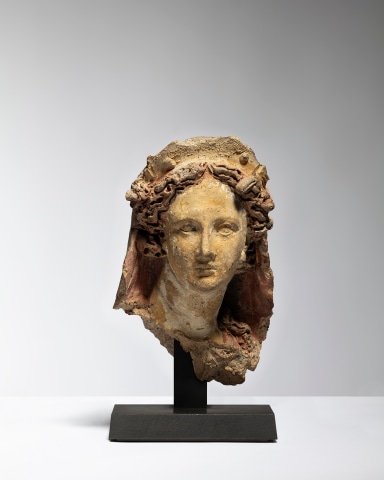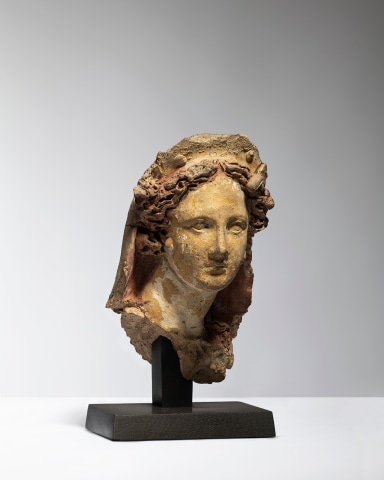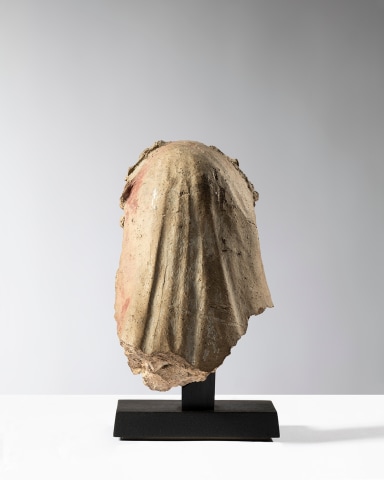Italo-Etruscan head of a goddess, Hellenistic, 1st half of 3rd century BC
Polychrome terracotta
Height: 18cm
12074
%3Cdiv%20class%3D%22title_and_year%22%3E%3Cem%3EItalo-Etruscan%20head%20of%20a%20goddess%3C/em%3E%2C%20%3Cspan%20class%3D%22title_and_year_year%22%3EHellenistic%2C%201st%20half%20of%203rd%20century%20BC%3C/span%3E%3C/div%3E%3Cdiv%20class%3D%22medium%22%3EPolychrome%20terracotta%3C/div%3E%3Cdiv%20class%3D%22dimensions%22%3EHeight%3A%2018cm%3C/div%3E%3Cdiv%20class%3D%22price%22%3E%C2%A3%2034%2C000%3C/div%3E
An idealised head of a young woman, almost certainly a goddess, most likely Aphrodite, although Artemis, Demeter and Fortuna are possible candidates. Her head, on a long neck marked with...
An idealised head of a young woman, almost certainly a goddess, most likely Aphrodite, although Artemis, Demeter and Fortuna are possible candidates. Her head, on a long neck marked with the ‘lines of beauty, is turned to her right in a distant, pensive gaze. The corners of her mouth, above a small, neat chin, are slightly downturned. A straight nose runs in an almost continuous line from her brow, and her large eyes, set beneath elongated curved eyebrows, are slightly upraised, the pupils incised. Her thick, wavy hair is centrally parted, falling around her ears, which have circular shield earrings, and down to her shoulders. She is crowned with a veil framing her face, arranged in vertical folds down the back, and held in place by a high diadem decorated with applied discs. Yellow ochre paint, overlaid with white, to her face, and a dark reddish brown is used for her hair and mantle with the headdress again painted in yellow. On her left shoulder the decoration to the neck of her gown can be seen.
The head is solid, fully modelled in the round, and formed of a micaceous clay, typical of the surroundings of Rome, or the region of the so-called Colli Albani south of Rome with important sites such as Ardea, Lanuvium and Nemi, or - more probably - Southern Etruria, in the area reaching from Caere (Cerveteri) to Falerii (Civita Castellana, 60 km north of Rome). The surface has been smoothed and traces of closely spaced parallel lines show where it has been scraped by a lightly toothed comb whilst the clay was still damp.
This head likely belonged to a fully hand-made pedimental high relief from a small temple, possibly of a scene containing various gods.
Provenance
19th century collection; previously fitted on a 19th century red velvet-covered base
Butterfield & Butterfield, Los Angeles, USA, 19th-20th March 1990
Private collection, Beverly Hills, USA; acquired from the above
Literature
The tool marks to the surface of the face are similar to those seen to the right cheek, eyebrows and across the bridge of the nose on the large terracotta head of Tinia, the Etruscan equivalent of Zeus, now in Munich Antikensammlungen, No. 5520 https://commons.wikimedia.org/wiki/File:Tinia_Staatliche_Antikensammlungen,_München,_2013.jpg
There is a polychrome terracotta female head, now in the Walters Art Gallery, Baltimore, USA, accession number 48.310, which exhibits in its fluidity of modelling a strong similarity, especially in the hair, although the head is not completely finished in the round.
Publications
Butterfield & Butterfield, Los Angeles, USA; Deluxe Furniture & Design, 19th-20th March 1990, lot 1929









